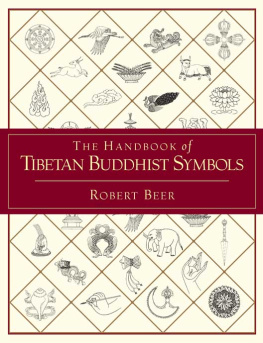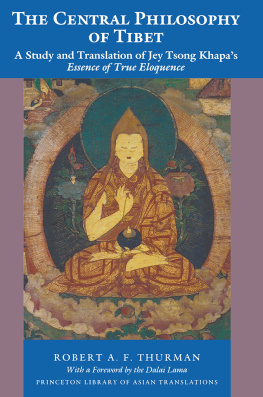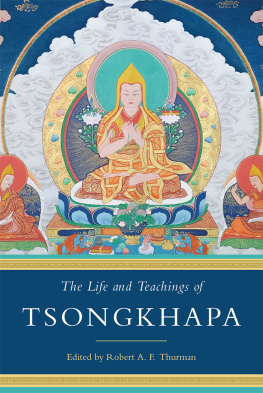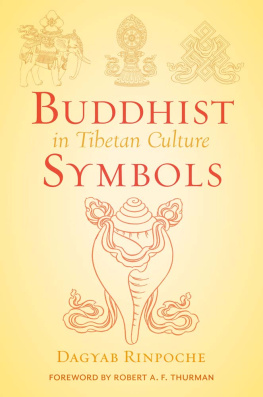Robert Beer - The Handbook of Tibetan Buddhist Symbols
Here you can read online Robert Beer - The Handbook of Tibetan Buddhist Symbols full text of the book (entire story) in english for free. Download pdf and epub, get meaning, cover and reviews about this ebook. publisher: Shambhala, genre: Religion. Description of the work, (preface) as well as reviews are available. Best literature library LitArk.com created for fans of good reading and offers a wide selection of genres:
Romance novel
Science fiction
Adventure
Detective
Science
History
Home and family
Prose
Art
Politics
Computer
Non-fiction
Religion
Business
Children
Humor
Choose a favorite category and find really read worthwhile books. Enjoy immersion in the world of imagination, feel the emotions of the characters or learn something new for yourself, make an fascinating discovery.
- Book:The Handbook of Tibetan Buddhist Symbols
- Author:
- Publisher:Shambhala
- Genre:
- Rating:4 / 5
- Favourites:Add to favourites
- Your mark:
- 80
- 1
- 2
- 3
- 4
- 5
The Handbook of Tibetan Buddhist Symbols: summary, description and annotation
We offer to read an annotation, description, summary or preface (depends on what the author of the book "The Handbook of Tibetan Buddhist Symbols" wrote himself). If you haven't found the necessary information about the book — write in the comments, we will try to find it.
The Handbook of Tibetan Buddhist Symbols — read online for free the complete book (whole text) full work
Below is the text of the book, divided by pages. System saving the place of the last page read, allows you to conveniently read the book "The Handbook of Tibetan Buddhist Symbols" online for free, without having to search again every time where you left off. Put a bookmark, and you can go to the page where you finished reading at any time.
Font size:
Interval:
Bookmark:
ABOUT THE BOOK
The Handbook of Tibetan Buddhist Symbols is a portal into the rich, multifaceted, and profound symbolism of Tibetan sacred art. Robert Beer provides a deep and encompassing insight into the vast array of symbols and attributes that appear within the complex iconography of Tibetan Buddhism. The succinct descriptions that accompany his detailed line drawings reveal the origins, meanings, and functions of these symbols. Beer unravels the multiple layers of symbolism and meaning contained within the iconography, affording the reader a panoramic vision into the deeper dimensions of this sacred art.
Drawn largely from Beers monumental work The Encyclopedia of Tibetan Symbols and Motifs, the meticulous brush drawings in this book depict all of the major Buddhist symbols and motifs, including the various groups of auspicious symbols; cosmological symbols; natural and mythical animals, such as the dragon, garuda, and makara; the entire assembly of ritual tantric implements and weapons; magical and wrathful symbols; handheld emblems, attributes, and plants; esoteric Vajrayana offerings; and mudras, or ritual hand gestures.
ROBERT BEER has studied and practiced Tibetan thangka painting for thirty years, including five years of study with master artists Jampa of Dharamsala and Khamtrl Rinpoche of Tashijong. Beer is one of the first Westerners to become actively involved in this art form. Over the last two decades he has concentrated on an extensive series of iconographical drawings depicting the major deities, lineage holders, and symbols that occur in the spectrum of Tibetan art.
Sign up to receive news and special offers from Shambhala Publications.

Or visit us online to sign up at shambhala.com/eshambhala.
The Handbook of
TIBETAN BUDDHIST SYMBOLS
Written and Illustrated by
ROBERT BEER

SHAMBHALA
Boulder
2015
SHAMHALA PUBLICATIONS, INC.
4720 Walnut Street
Boulder, Colorado 80301
www.shambhala.com
2003 by Robert Beer
Cover design by Jim Zaccaria
Cover art by Robert Beer
All rights reserved. No part of this book may be reproduced in any form or by any means, electronic or mechanical, including photocopying, recording, or by any information storage and retrieval system, without permission in writing from the publisher.
Library of Congress Cataloging-in-Publication Data
Beer, Robert.
The handbook of Tibetan Buddhist symbols / Written and illustrated by Robert Beer.
p. cm.
eISBN 978-0-8348-2423-2
ISBN 978-1-59030-100-5
1. Art, TibetanThemes, motives. 2. Symbolism in artChinaTibet. I. Title: Tibetan symbols. II. Title.
N7346.T5B436 2003
704.946'09515dc21
2003045433
Page number cross-references from the original print book have been retained in this electronic edition. A hyperlink on such references will direct you to the relevant section of the e-book.

P rimarily I would like to express my gratitude to my partner Gill Farrer-Halls for lovingly taking care of me throughout the many months of solitude in writing this text, and for making many helpful editorial suggestions. I express my thanks to Anthony Aris and his wife Marie Laure, and to Shane Suvikapakornkul of Serindia Publications for their constant encouragement, and to Jonathan Green and the staff of Shambhala Publications. For financial assistance I would like to thank Jane Reed and the Harold Hyam Wingate Foundation in London. The layout and design of this book was accomplished with the assistance of Toby Matthews in London, a man of great skill, diligence, and patience.
Gratitude is expressed to all my many friends around this world for their support. In particular I would like to thank Ani Jampa, Phunsok Tsering, Evan Dvorsek, David Ford, Liz Specterman, Robert Svoboda, Marc Baudin, Judy Allan, Khalil Norland, Danah Zohar and Ian Marshall for their constant friendship and generosity, and to Christina, Thomas, Kali, Mac, and to Mike, Phil, and Leigh of Wisdom Books in London. I would also like to thank my friends Edward Henning, Martin Willson, Martin Boord, Ani Tenzin Palmo, Stephen and Martine Batchelor, and Karma Phunsok for their dedicated work and insight into Vajrayana Buddhism. My thanks are also expressed to my daughters Carrina and Rosia, and to Helen for bringing such jewels into this world.
True democracy occurs when soul meets soul on the open road. There are so many fine people whom I have met upon this road of the alone that have touched me deeply. They know well who they are, even though they are not all mentioned by name.


I n the summer of 1999 I completed the text of The Encyclopedia of Tibetan Symbols and Motifs (Boulder: Shambhala; London: Serindia). This book took a long time in its making. The brush drawings alone took almost eight years to complete, and were created in a prolonged period of semi-retreat in the remote Western Highlands of Scotland. By comparison the writing of the text was relatively quick and painless. When there is much to say words are easy to come by, and perhaps my greatest difficulty was in knowing when to stop. After writing nearly a quarter of a million words my publisher and editor brought the chopper down. The book was way past its deadline, and there wasnt even time left to create an index. But I felt it was a good and original work, although I also felt it was virtually being presented in its first draft.
At the beginning of 2000 I wrote a concise pictorial index for Deities of Tibetan Buddhism (Willson, M. and Brauen, M. 2000. Boston: Wisdom). Martin Willson spent around fourteen years translating and annotating the Tibetan texts for this work, which covers the abridged descriptions of just over five hundred deities. With the almost simultaneous publication of these two works I felt that some original insight had been presented on the complex symbolism of Vajrayana art.
This Handbook is based on a synthesis from the original text of The Encyclopedia, and of the condensed version that appears in Deities of Tibetan Buddhism. Although only a limited selection of my original drawings appear in this book, and the scope of the subject matter has been reduced, I feel that this material is now presented in a more accessible and user-friendly format.
I have tried to structure the contents of this book into a logical progression, so that the many lists of numerical concepts, which are so characteristic of the Buddhist teachings, are gradually introduced into the text. The first five sections of this Handbook covers the main groups of auspicious symbols, offerings, and emblems, many of which appeared as the first symbolic motifs of early Indian Buddhism. The sixth section deals with the origins of the main natural and mythological animals that appear in Buddhist art. The seventh section deals with the cosmological symbols of the sun and moon, the five elements, Mount Meru, and the mandala offering. The eighth section introduces the main ritual Vajrayana implements of the vajra and bell, crossed-vajra, and ritual dagger, and the tantric kapalika attributes of the
Next pageFont size:
Interval:
Bookmark:
Similar books «The Handbook of Tibetan Buddhist Symbols»
Look at similar books to The Handbook of Tibetan Buddhist Symbols. We have selected literature similar in name and meaning in the hope of providing readers with more options to find new, interesting, not yet read works.
Discussion, reviews of the book The Handbook of Tibetan Buddhist Symbols and just readers' own opinions. Leave your comments, write what you think about the work, its meaning or the main characters. Specify what exactly you liked and what you didn't like, and why you think so.












